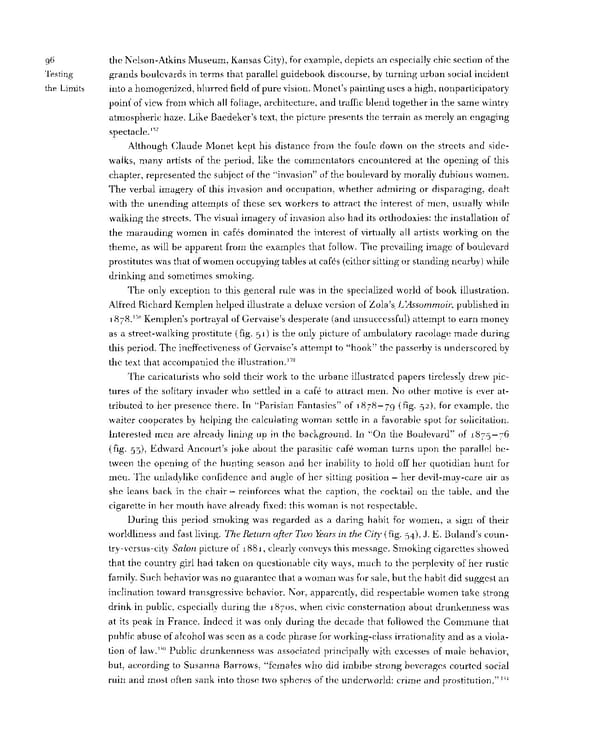96 the Nelson-Atkins Museum, Kansas City), for example, depicts an especially chic section of the Testing grands boulevards in terms that parallel guidebook discourse, by turning urban social incident the Limits into a homogenized, blurred field of pure vision. Monet's painting uses a high, nonparticipatory point of view from which all foliage, architecture, and traffic blend together in the same wintry atmospheric haze. Like Baedeker's text, the picture presents the terrain as merely an engaging spectacle.137 Although Claude Monet kept his distance from the foule down on the streets and side- walks, many artists of the period, like the commentators encountered at the opening of this chapter, represented the subject of the "invasion" of the boulevard by morally dubious women. The verbal imagery of this invasion and occupation, whether admiring or disparaging, dealt with the unending attempts of these sex workers to attract the interest of men, usually while walking the streets. The visual imagery of invasion also had its orthodoxies: the installation of the marauding women in cafes dominated the interest of virtually all artists working on the theme, as will be apparent from the examples that follow. The prevailing image of boulevard prostitutes was that of women occupying tables at cafes (either sitting or standing nearby) while drinking and sometimes smoking. The only exception to this general rule was in the specialized world of book illustration. Alfred Richard Kemplen helped illustrate a deluxe version of Zola's L'Assommoir, published in 158 iS/S. Kemplen's portrayal of Gervaise's desperate (and unsuccessful) attempt to earn money as a street-walking prostitute (fig. 51) is the only picture of ambulatory racolage made during this period. The ineffectiveness of Gervaise's attempt to "hook" the passerby is underscored by the text that accompanied the illustration.139 The caricaturists who sold their work to the urbane illustrated papers tirelessly drew pic- tures of the solitary invader who settled in a cafe to attract men. No other motive is ever at- tributed to her presence there. In "Parisian Fantasies" of 1878 — 79 (fig. 52), for example, the waiter cooperates by helping the calculating woman settle in a favorable spot for solicitation. Interested men are already lining up in the background. In "On the Boulevard" of 1875 — 76 (fig. 53), Edward Ancourt's joke about the parasitic cafe woman turns upon the parallel be- tween the opening of the hunting season and her inability to hold off her quotidian hunt for men. The unladylike confidence and angle of her sitting position — her devil-may-care air as she leans back in the chair — reinforces what the caption, the cocktail on the table, and the cigarette in her mouth have already fixed: this woman is not respectable. During this period smoking was regarded as a daring habit for women, a sign of their worldliness and fast living. The Return after Two Years in the City (fig. 54), J. E. Buland's coun- try-versus-city Salon picture of 1881, clearly conveys this message. Smoking cigarettes showed that the country girl had taken on questionable city ways, much to the perplexity of her rustic family. Such behavior was no guarantee that a woman was for sale, but the habit did suggest an inclination toward transgressive behavior. Nor, apparently, did respectable women take strong drink in public, especially during the 18708, when civic consternation about drunkenness was at its peak in France. Indeed it was only during the decade that followed the Commune that public abuse of alcohol was seen as a code phrase for working-class irrationality and as a viola- 140 tion of law. Public drunkenness was associated principally with excesses of male behavior, but, according to Susanna Barrows, "females who did imbibe strong beverages courted social ruin and most often sank into those two spheres of the underworld: crime and prostitution." 141
 Prostitution & Impressionists Page 116 Page 118
Prostitution & Impressionists Page 116 Page 118